Spatio-Temporal Characteristics of Ship Carbon Emissions in Port of New York and New Jersey Based on AIS Data
Abstract
1. Introduction
2. Materials and Methods
2.1. Study Area
2.2. Materials
2.2.1. Data Collection
2.2.2. Data Cleansing
2.2.3. Remove Outlier Trajectory Points
2.2.4. Data Interpolation
2.3. Methodology
2.3.1. Calculation of Ship Carbon Emission Based on AIS
Operation State
Vessel Activity Parameters
- (1)
- Engine power;
- (2)
- Load factor;
- (3)
- Emission factor;
2.3.2. Space Allocation
3. Results and Analysis
3.1. Analysis of Total Carbon Emissions from Ships
3.2. Spatio-Temporal Analysis of Carbon Emissions
3.2.1. Temporal Variation of Carbon Emissions
3.2.2. Spatial Variation of Carbon Emissions
4. Discussion
5. Conclusions
- The accuracy of carbon emission estimates relies heavily on high-quality data, including vessel operational parameters (such as engine power and fuel consumption), load factor, and emission factor calculations. However, due to challenges in data collection and organization, the absence or insufficient representativeness of key data, and potential data loss during cleaning processes, carbon emission calculations may contain errors, introducing a degree of uncertainty. Specific AE/ME ratios and AE load factors for the NY/NJ region were not available and were taken from prior literature. These parameters are the primary contributors to current parametric uncertainty, which can be refined upon local validation.
- This study did not account for external environmental factors such as wind speed, tidal currents, and wave conditions. These elements can influence vessel speed and engine load, thereby affecting carbon emission levels.
- Enhance the processing of AIS data by employing more effective anomaly point removal and convexification techniques to minimize impacts from data handling.
- Future studies should integrate real-time operational data (e.g., engine performance, fuel flow, energy consumption) to optimize emission estimates through intelligent sensor systems, thereby improving model accuracy. Establishing high-frequency sensor networks to monitor real-time operational changes of vessels within ports will provide valuable data for emission model validation.
- Incorporating external environmental factors (e.g., wind speed, tidal currents, sea conditions) into emission models is critical. This will enable more refined carbon emission predictions under varying weather conditions and improve spatial accuracy for emissions in specific port areas.
- Additionally, conducting long-term studies to track the impact of policy interventions (e.g., ECA regulations) on emission changes will provide valuable insights for future emission reduction strategies.
Author Contributions
Funding
Data Availability Statement
Conflicts of Interest
Abbreviations
| AIS | Automatic Identification System |
| IMO | International Maritime Organization |
| STEAM | Ship Traffic Emissions Assessment Model |
| MMSI | Maritime Mobile Service Identity value |
| ME | main engine |
| AE | auxiliary engine |
| AB | auxiliary boiler |
| LF | load factor |
| EF | emission factor |
| MCR | Maximum Continuous Rating |
| GT | gross tonnage |
| DWT | deadweight tonnage |
Appendix A. Reproducibility Note
- (1)
- Key parameters
- (2)
- (3)
- Link to the NOAA AIS data source used (https://hub.marinecadastre.gov/pages/vesseltraffic)
Appendix B. Sensitivity Analysis
| Changes in Various Elements | Changes in Carbon Emissions | Changes in Carbon Emissions During Berthing |
|---|---|---|
| LFME ± 10% | ±1.85% | - |
| AE/ME power ratios ± 20% | ±13.21% | ±16.06% |
| AE load factors ± 20% | ±13.21% | ±16.06% |
| EF ± 5% | ±5% | ±5% |
References
- UNCTAD. Review of Maritime Transport 2022; United Nations Conference on Trade and Development: Geneva, Switzerland, 2022. [Google Scholar]
- Yang, L.; Zhang, Q.; Lv, Z.; Zhang, Y.; Yang, Z.; Fu, F.; Lv, J.; Wu, L.; Mao, H. Efficiency of DECA on ship emission and urban air quality: A case study of China port. J. Clean. Prod. 2022, 362, 132556. [Google Scholar] [CrossRef]
- Issa-Zadeh, S.B.; Garay-Rondero, C.L. Decarbonizing Seaport Maritime Traffic: Finding Hope. World 2025, 6, 47. [Google Scholar] [CrossRef]
- IMO. Fourth IMO Greenhouse Gas Study 2020; International Maritime Organization: London, UK, 2020. [Google Scholar]
- Park, S.-Y.; Woo, S.-H.; Lim, C. Predicting PM10 and PM2.5 concentration in container ports: A deep learning approach. Transp. Res. Part D Transp. Environ. 2023, 115, 103601. [Google Scholar] [CrossRef]
- Wang, L.; Li, Y. Estimation methods and reduction strategies of port carbon emissions—What literatures say? Mar. Pollut. Bull. 2023, 195, 115451. [Google Scholar] [CrossRef] [PubMed]
- Gray, N.; McDonagh, S.; O’Shea, R.; Smyth, B.; Murphy, J.D. Decarbonising ships, planes and trucks: An analysis of suitable low-carbon fuels for the maritime, aviation and haulage sectors. Adv. Appl. Energy 2021, 1, 100008. [Google Scholar] [CrossRef]
- Bach, H.; Hansen, T. IMO off course for decarbonisation of shipping? Three challenges for stricter policy. Mar. Policy 2023, 147, 105379. [Google Scholar] [CrossRef]
- IMO. Revised GHG Reduction Strategy for Global Shipping Adopted; International Maritime Organization: London, UK, 2023. [Google Scholar]
- Habibi, M.; Rehmatulla, N. Carbon Emission Policies in the Context of the Shipping Industry; CASS Business School, City University: London, UK, 2009. [Google Scholar]
- Iris, C.; Lam, J.S.L. A review of energy efficiency in ports: Operational strategies, technologies and energy management systems. Renew. Sustain. Energy Rev. 2019, 112, 170–182. [Google Scholar] [CrossRef]
- The Long-Term Strategy of the United States Pathways to Net-Zero Greenhouse Gas. 2021. Available online: https://bidenwhitehouse.archives.gov/wp-content/uploads/2021/10/US-Long-Term-Strategy.pdf#:~:text=In%202021%2C%20we%20rejoined%20the%20Paris%20Agreement%2C%20set,actions%20to%20advance%20climate%20action%20domestically%20and%20internationally (accessed on 6 May 2025).
- Wang, P.; Hu, Q.Y.; Xie, W.X.; Wu, L.; Wang, F.; Mei, Q. Big data-driven carbon emission traceability list and characteristics of ships in maritime transportation-a case study of Tianjin Port. Environ. Sci. Pollut. Res. 2023, 30, 71103–71119. [Google Scholar] [CrossRef]
- Feng, Y.; Wang, X.; Luan, J.; Wang, H.; Li, H.; Li, H.; Liu, Z.; Yang, Z. A novel method for ship carbon emissions prediction under the influence of emergency events. Transp. Res. Part C Emerg. Technol. 2024, 165, 104749. [Google Scholar] [CrossRef]
- Toscano, D.; Murena, F.; Quaranta, F.; Mocerino, L. Assessment of the impact of ship emissions on air quality based on a complete annual emission inventory using AIS data for the port of Naples. Ocean Eng. 2021, 232, 109166. [Google Scholar] [CrossRef]
- Yang, H.; Ma, X.; Xing, Y. Trends in CO2 Emissions from China-Oriented International Marine Transportation Activities and Policy Implications. Energies 2017, 10, 980. [Google Scholar] [CrossRef]
- Endresen, Ø.; Sørgård, E.; Sundet, J.K.; Dalsøren, S.B.; Isaksen, I.S.; Berglen, T.F.; Gravir, G. Emission from international sea transportation and environmental impact. J. Geophys. Res. Atmos. 2003, 108, 4560. [Google Scholar] [CrossRef]
- Nguyen, P.-N.; Woo, S.-H.; Kim, H. Ship emissions in hotelling phase and loading/unloading in Southeast Asia ports. Transp. Res. Part D Transp. Environ. 2022, 105, 103223. [Google Scholar] [CrossRef]
- Wang, K.; Wang, J.H.; Huang, L.Z.; Yuan, Y.P.; Wu, G.T.; Xing, H.; Wang, Z.Y.; Wang, Z.; Jiang, X.L. A comprehensive review on the prediction of ship energy consumption and pollution gas emissions. Ocean Eng. 2022, 266, 112826. [Google Scholar] [CrossRef]
- Chen, S.K.; Meng, Q.; Jia, P.; Kuang, H.B. An operational-mode-based method for estimating ship emissions in port waters. Transp. Res. Part D Transp. Environ. 2021, 101, 103080. [Google Scholar] [CrossRef]
- Chen, Z.S.; Lam, J.S.L.; Xiao, Z. Prediction of harbour vessel emissions based on machine learning approach. Transp. Res. Part D Transp. Environ. 2024, 131, 104214. [Google Scholar] [CrossRef]
- Chen, D.S.; Wang, X.T.; Li, Y.; Lang, J.L.; Zhou, Y.; Guo, X.R.; Zhao, Y.H. High-spatiotemporal-resolution ship emission inventory of China based on AIS data in 2014. Sci. Total Environ. 2017, 609, 776–787. [Google Scholar] [CrossRef]
- Juan-Carlos, M.G. Analysis and measurement of SOx, CO2, PM and NOx emissions in port auxiliary vessels. Environ. Monit. Assess. 2021, 193, 374. [Google Scholar] [CrossRef]
- Fuentes Garcia, G.; Baldasano Recio, J.M.; Sosa Echeverria, R.; Granados Hernandez, E.; Zamora Vargas, E.; Antonio Duran, R.; Kahl, J.W. Estimation of atmospheric emissions from maritime activity in the Veracruz port, Mexico. J. Air Waste Manag. Assoc. 2021, 71, 934–948. [Google Scholar] [CrossRef] [PubMed]
- Li, Y.; Li, H.; Zhang, C.; Zhao, Y.; Yang, Z. Incorporation of adaptive compression into a GPU parallel computing framework for analyzing large-scale vessel trajectories. Transp. Res. Part C Emerg. Technol. 2024, 163, 104648. [Google Scholar] [CrossRef]
- Dettner, F.; Hilpert, S. Modelling CO2 emissions and mitigation potential of Northern European shipping. Transp. Res. Part D Transp. Environ. 2023, 119, 1313. [Google Scholar] [CrossRef]
- Yuan, Y.; Zhang, Y.; Mao, J.; Yu, G.; Xu, K.; Zhao, J.; Qian, H.; Wu, L.; Yang, X.; Chen, Y.; et al. Diverse changes in shipping emissions around the Western Pacific ports under the coeffect of the epidemic and fuel oil policy. Sci. Total Environ. 2023, 879, 162892. [Google Scholar] [CrossRef]
- Jalkanen, J.-P.; Brink, A.; Kalli, J.; Pettersson, H.; Kukkonen, J.; Stipa, T. A modelling system for the exhaust emissions of marine traffic and its application in the Baltic Sea area. Atmos. Chem. Phys. 2009, 9, 9209–9223. [Google Scholar] [CrossRef]
- Jalkanen, J.-P.; Johansson, L.; Kukkonen, J. A comprehensive inventory of ship traffic exhaust emissions in the European sea areas in 2011. Atmos. Chem. Phys. 2016, 16, 71–84. [Google Scholar] [CrossRef]
- Johansson, L.; Jalkanen, J.-P.; Kukkonen, J. Global assessment of shipping emissions in 2015 on a high spatial and temporal resolution. Atmos. Environ. 2017, 167, 403–415. [Google Scholar] [CrossRef]
- Li, H.; Jia, P.; Wang, X.; Yang, Z.; Wang, J.; Kuang, H. Ship carbon dioxide emission estimation in coastal domestic emission control areas using high spatial-temporal resolution data: A China case. Ocean Coast. Manag. 2023, 232, 106419. [Google Scholar] [CrossRef]
- Weng, J.; Shi, K.; Gan, X.; Li, G.; Huang, Z. Ship emission estimation with high spatial-temporal resolution in the Yangtze River estuary using AIS data. J. Clean. Prod. 2020, 248, 119297. [Google Scholar] [CrossRef]
- Li, Y.; Jia, P.; Jiang, S.; Li, H.; Kuang, H.; Hong, Y.; Wang, S.; Zhao, X.; Guan, D. The climate impact of high seas shipping. Natl. Sci. Rev. 2023, 10, nwac279. [Google Scholar] [CrossRef] [PubMed]
- Sun, Y.; Lian, F.; Yang, Z. Analysis of the activities of high sea fishing vessels from China, Japan, and Korea via AIS data mining. Ocean Coast. Manag. 2023, 242, 106690. [Google Scholar] [CrossRef]
- Mou, N.; Zhang, X.; Yang, T.; Xu, H.; Zheng, Y.; Wang, J.; Niu, J. Carbon footprints: Uncovering multilevel spatiotemporal changes of ship emissions during 2019–2021 in the US. Sci. Total Environ. 2024, 912, 169395. [Google Scholar] [CrossRef] [PubMed]
- He, Z.; Lam, J.S.L.; Liang, M. Impact of Disruption on Ship Emissions in Port: Case of Pandemic in Long Beach. Sustainability 2023, 15, 7215. [Google Scholar] [CrossRef]
- Xiao, G.; Wang, T.; Chen, X.; Zhou, L. Evaluation of Ship Pollutant Emissions in the Ports of Los Angeles and Long Beach. J. Mar. Sci. Eng. 2022, 10, 1206. [Google Scholar] [CrossRef]
- Styhre, L.; Winnes, H.; Black, J.; Lee, J.; Le-Griffin, H. Greenhouse gas emissions from ships in ports—Case studies in four continents. Transp. Res. Part D Transp. Environ. 2017, 54, 212–224. [Google Scholar] [CrossRef]
- Venturini, G.; Iris, C.; Kontovas, C.A.; Larsen, A. The multi-port berth allocation problem with speed optimization and emission considerations. Transp. Res. Part D Transp. Environ. 2017, 54, 142–159. [Google Scholar] [CrossRef]
- Ye, J.; Chen, J.; Wen, H.; Wan, Z.; Tang, T. Emissions assessment of bulk carriers in China’s east Coast-Yangtze River maritime network based on different shipping modes. Ocean Eng. 2022, 249, 110903. [Google Scholar] [CrossRef]
- Wang, X.; Yi, W.; Lv, Z.; Deng, F.; Zheng, S.; Xu, H.; Zhao, J.; Liu, H.; He, K. Ship emissions around China under gradually promoted control policies from 2016 to 2019. Atmos. Chem. Phys. 2021, 21, 13835–13853. [Google Scholar] [CrossRef]
- Qi, Y.; Yang, J.; Qin, K.S. Spatial-temporal analysis of carbon emissions from ships in ports based on AIS data. Ocean Eng. 2024, 308, 118394. [Google Scholar] [CrossRef]
- Sun, Z.; Xu, S.; Jiang, J. Spatial-temporal characteristics of ship carbon emission based on AIS data. Ocean Coast. Manag. 2025, 265, 107629. [Google Scholar] [CrossRef]
- Meng, Z.; Comer, B. Electrifying Ports to Reduce Diesel Pollution from Ships and Trucks and Benefit Public Health: Case Studies of the PORT of Seattle and the Port of New York and New Jersey; International Council on Clean Transportation: Washington, DC, USA, 2023. [Google Scholar]
- Semchukova, V.; Topolski, K.; Abdin, Z. Hydrogen technology for maritime applications: A review of challenges, opportunities, and lessons from the port authority of New York and New Jersey. Renew. Sustain. Energy Rev. 2025, 216, 115641. [Google Scholar] [CrossRef]
- Chen, Y.; Chen, Y.; Cui, Y.; Cai, X.; Yin, C.; Cheng, Y. Optimizing vessel trajectories: Advanced denoising and interpolation techniques for AIS data. Ocean Eng. 2025, 327, 120988. [Google Scholar] [CrossRef]
- Huang, L.; Wen, Y.; Zhang, Y.; Zhou, C.; Zhang, F.; Yang, T. Dynamic calculation of ship exhaust emissions based on real-time AIS data. Transp. Res. Part D Transp. Environ. 2020, 80, 102277. [Google Scholar] [CrossRef]
- Issa Zadeh, S.B.; López Gutiérrez, J.S.; Esteban, M.D.; Fernández-Sánchez, G.; Garay-Rondero, C.L. A Framework for Accurate Carbon Footprint Calculation in Seaports: Methodology Proposal. J. Mar. Sci. Eng. 2023, 11, 1007. [Google Scholar] [CrossRef]
- Huang, H.; Zhou, C.; Huang, L.; Xiao, C.; Wen, Y.; Li, J.; Lu, Z. Inland ship emission inventory and its impact on air quality over the middle Yangtze River, China. Sci. Total Environ. 2022, 843, 156770. [Google Scholar] [CrossRef]
- Cai, X.; Chen, Y.; Chen, Y. Estimation and analysis of carbon emissions from ships in the Yangtze River Delta coastal region based on AIS data. Acta Sci. Circumstantiae 2024, 44, 83–97. (In Chinese) [Google Scholar] [CrossRef]
- Zeng, F.; Jing, L. Ship emission inventory and valuation of eco-efficiency in Xiamen PortShip emission inventory and valuation of eco-efficiency in Xiamen Port. China Environ. Sci. 2020, 40, 2304–2311. [Google Scholar] [CrossRef]
- EPA. Port Emissions Inventory Guidance: Methodologies for Estimating Port-Related and Goods Movement Mobile Source Emissions; Environmental Protection Agency: Washington, DC, USA, 2022. [Google Scholar]
- Yu, H.; Fang, Q.; Fang, Z.; Xu, L.; Liu, J. Carbon footprints: Uncovering spatiotemporal dynamics of global container ship emissions during 2015–2021. Mar. Pollut. Bull. 2024, 209, 117165. [Google Scholar] [CrossRef]
- Yao, D.; Yue, M.; Zhang, X.; Wu, F.; Cheng, S. Model for Predicting Ship Emission Pollutants Based on MASTGCN using AIS Information. J. Transp. Inf. Saf. 2025, 43, 63–73. (In Chinese) [Google Scholar] [CrossRef]
- Lv, Z.; Liu, H.; Ying, Q.; Fu, M.; Meng, Z.; Wang, Y.; Wei, W.; Gong, H.; He, K. Impacts of shipping emissions on PM2.5 pollution in China. Atmos. Chem. Phys. 2018, 18, 15811–15824. [Google Scholar] [CrossRef]
- Ding, Y.; Hu, Z.; Dong, D. A density prediction method for fishing vessel based on deep learning and fusion of spatial-temporal features. J. Appl. Oceanogr. 2024, 43, 350–359. (In Chinese) [Google Scholar] [CrossRef]
- Goldsworthy, L.; Goldsworthy, B. Modelling of ship engine exhaust emissions in ports and extensive coastal waters based on terrestrial AIS data—An Australian case study. Environ. Model. Softw. 2015, 63, 45–60. [Google Scholar] [CrossRef]
- Chen, X.; Dou, S.; Song, T.; Wu, H.; Sun, Y.; Xian, J. Spatial-Temporal Ship Pollution Distribution Exploitation and Harbor Environmental Impact Analysis via Large-Scale AIS Data. J. Mar. Sci. Eng. 2024, 12, 960. [Google Scholar] [CrossRef]
- Eide, M.S.; Longva, T.; Hoffmann, P.; Endresen, Ø.; Dalsøren, S.B. Future cost scenarios for reduction of ship CO2 emissions. Marit. Policy Manag. 2011, 38, 11–37. [Google Scholar] [CrossRef]
- Johnson, H.; Styhre, L. Increased energy efficiency in short sea shipping through decreased time in port. Transp. Res. Part A Policy Pract. 2015, 71, 167–178. [Google Scholar] [CrossRef]
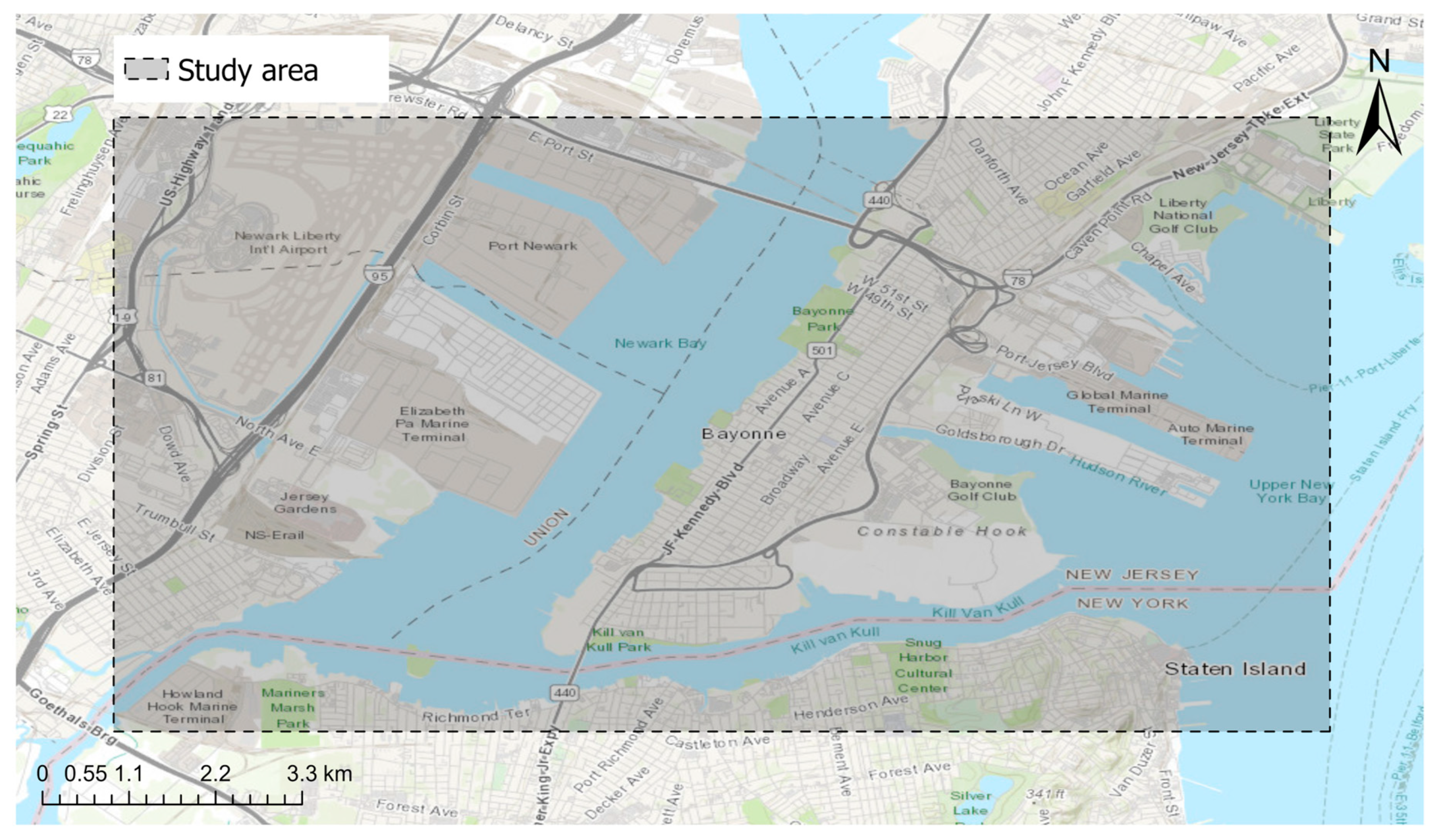


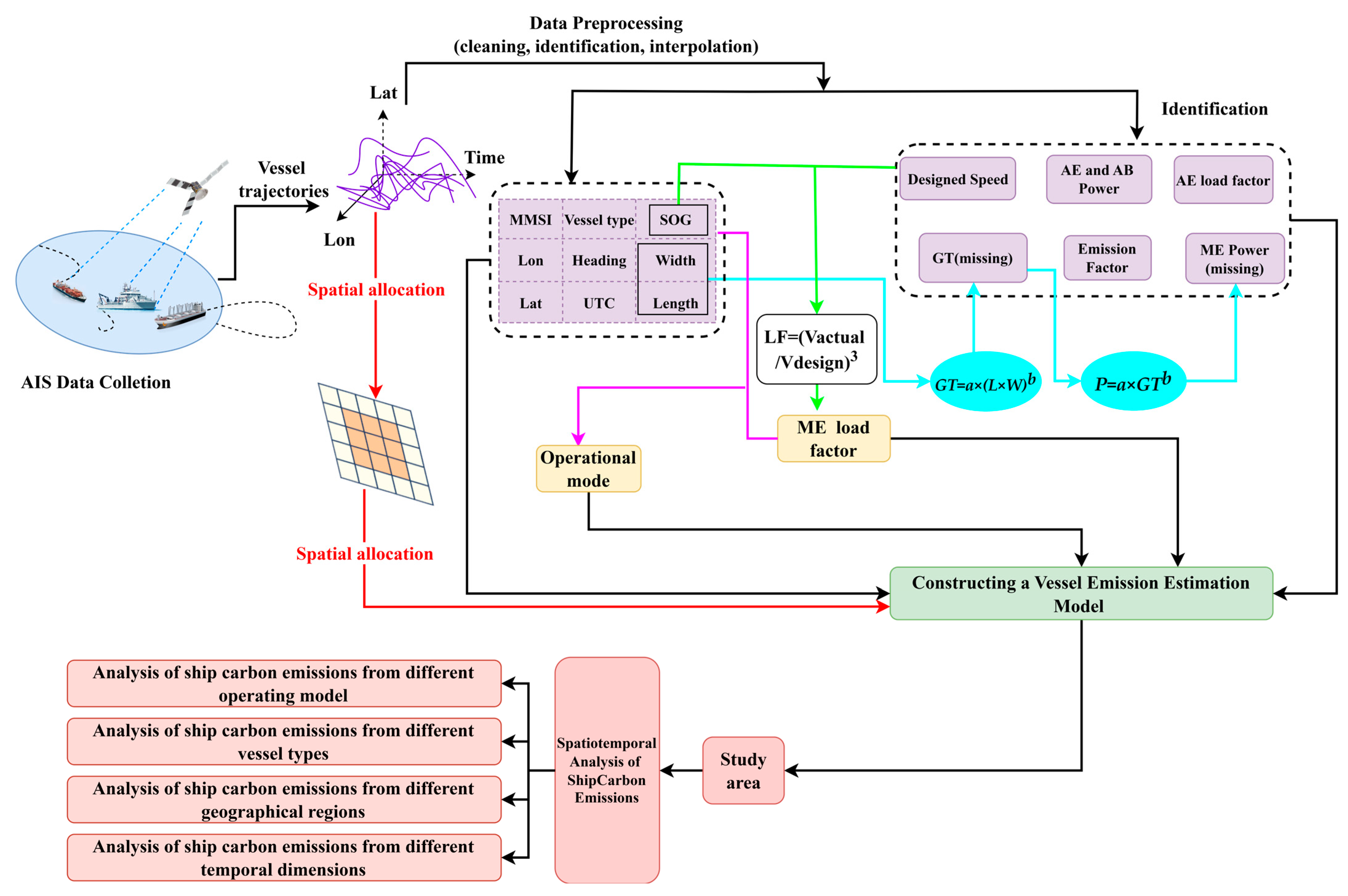

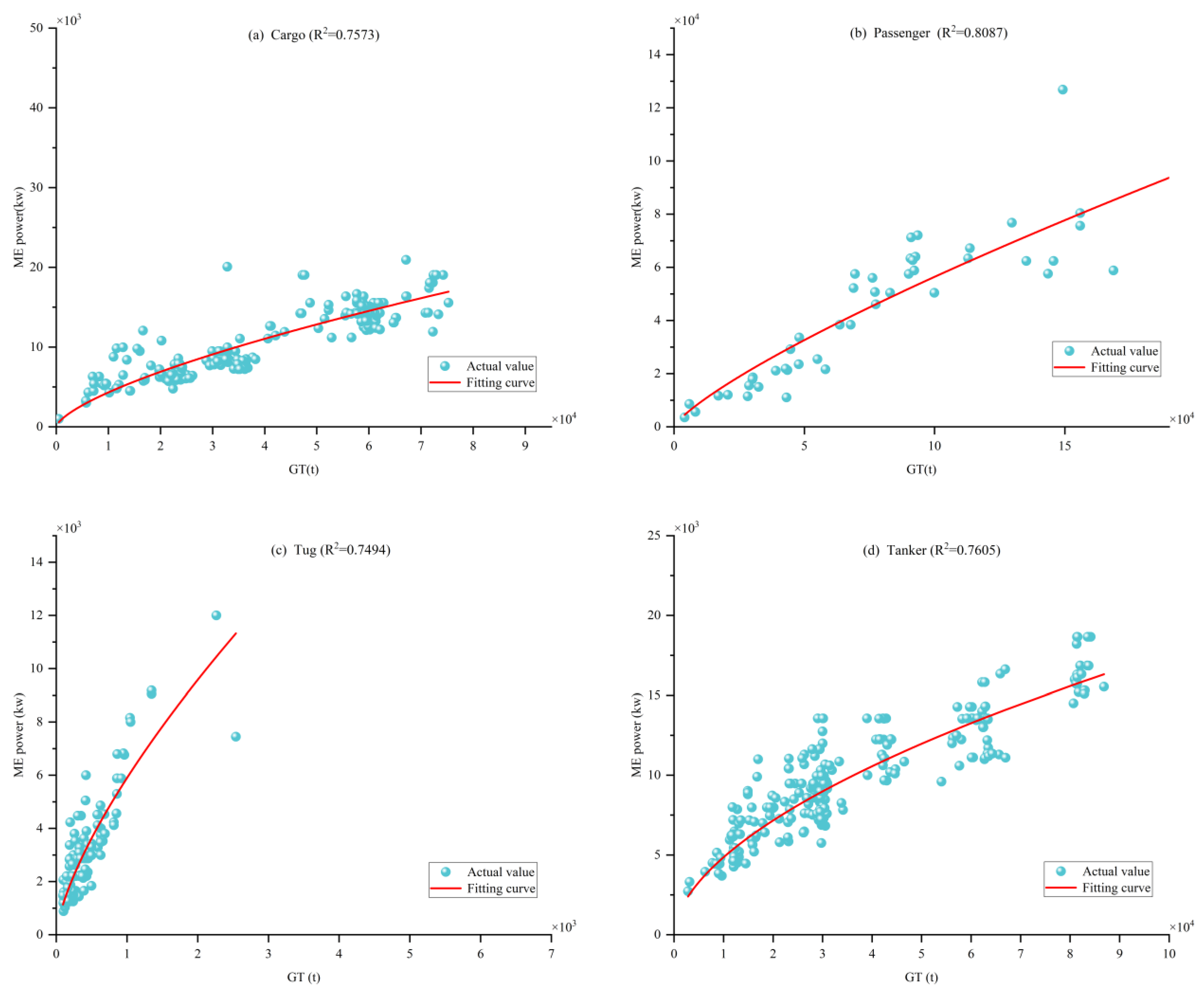

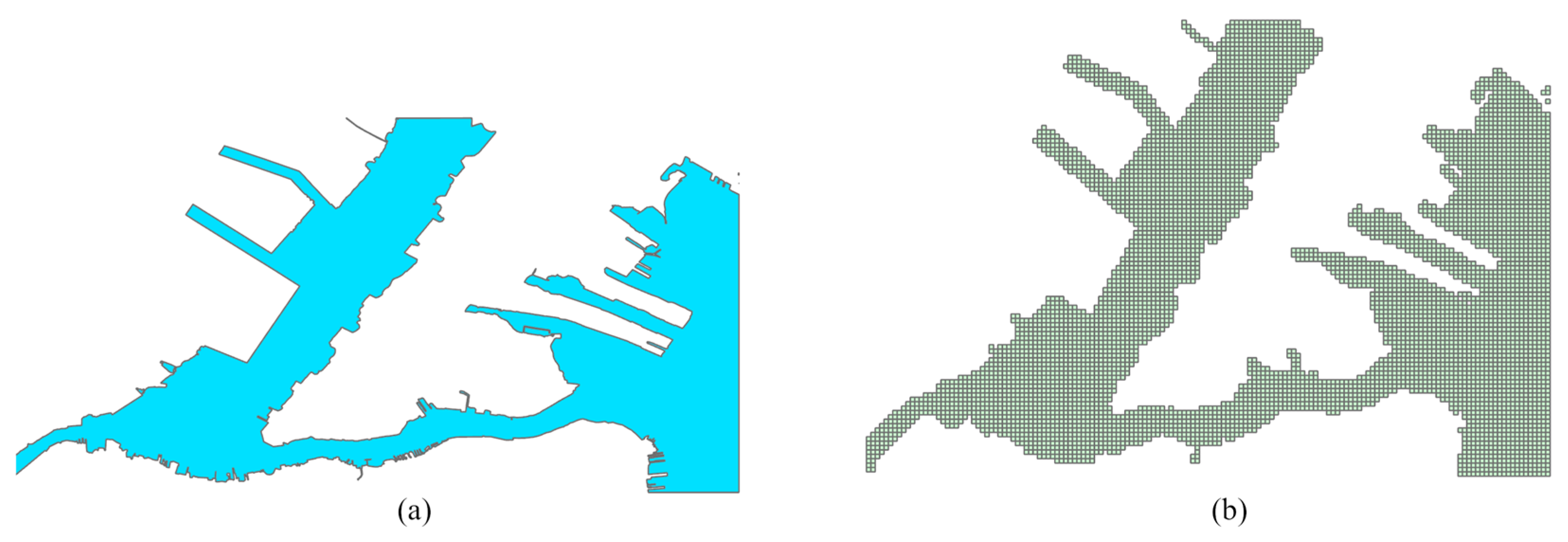
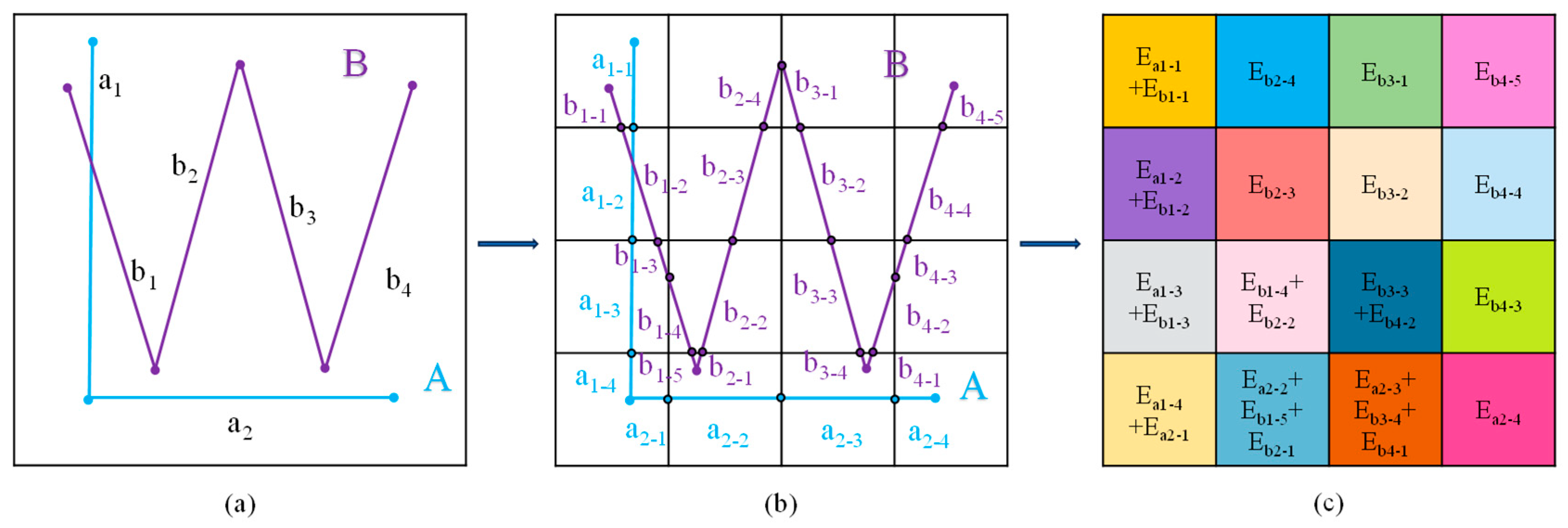


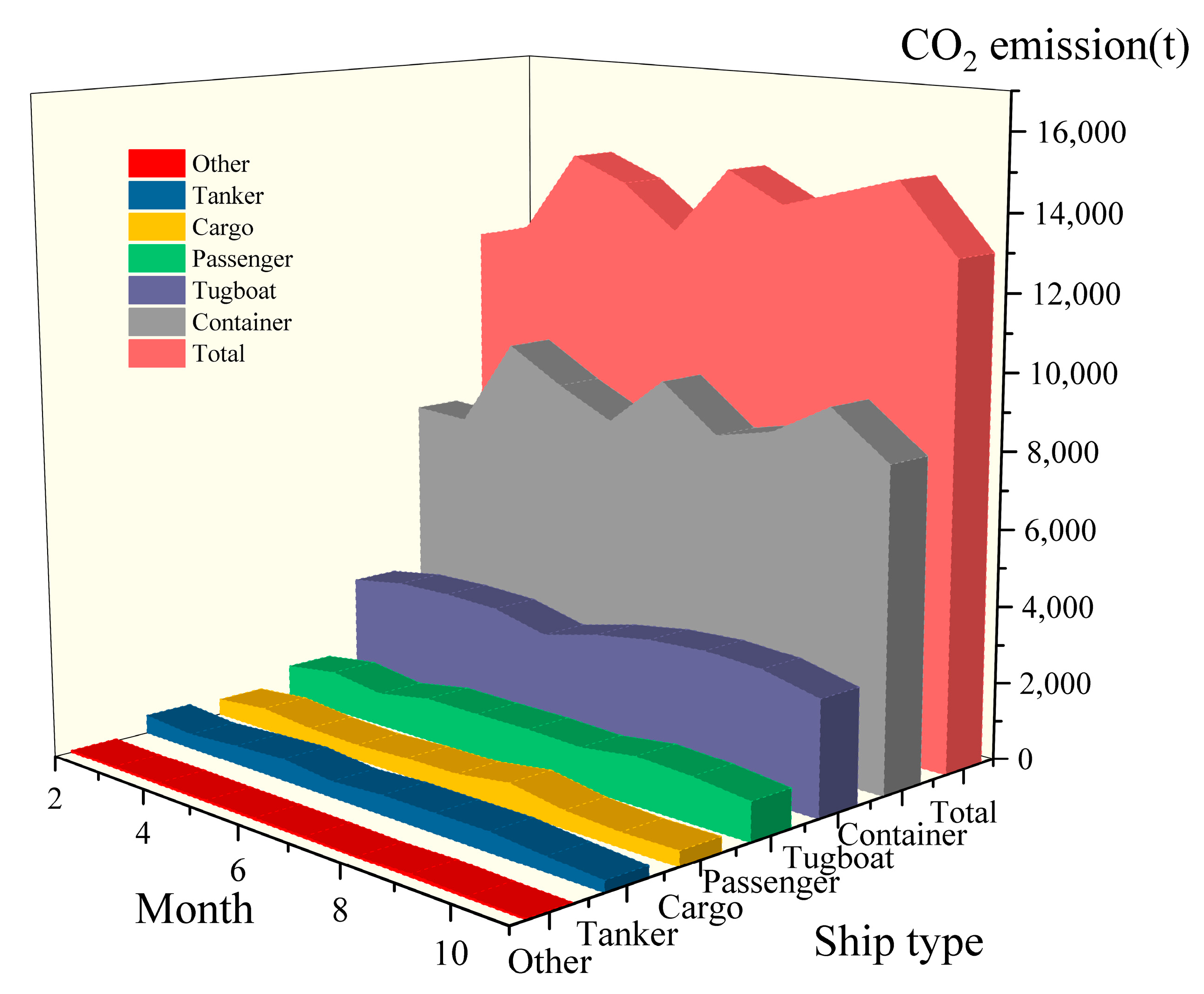
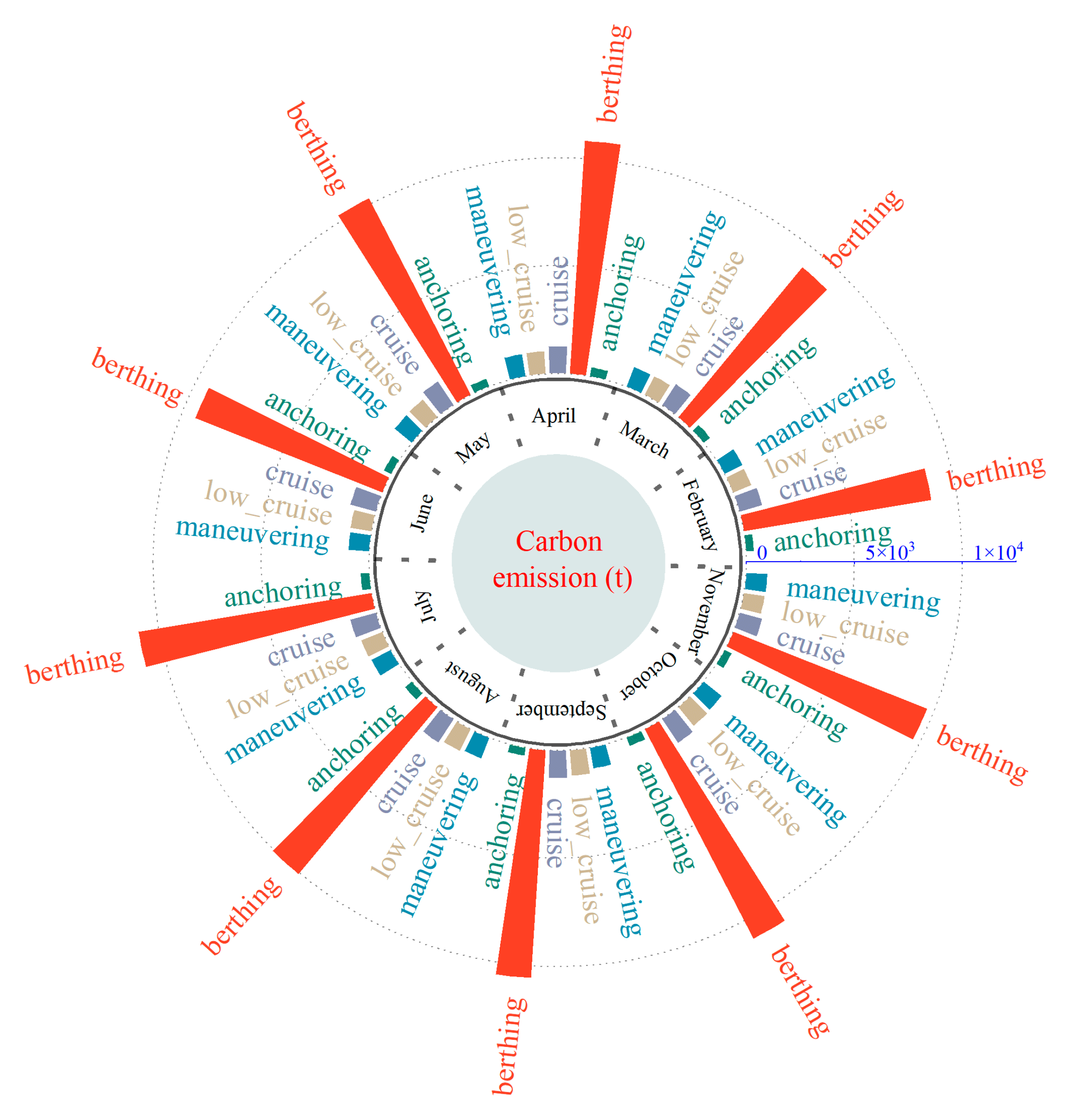

| Type | Name | Description | Example |
|---|---|---|---|
| Static data | MMSI | Maritime Mobile Service Identity value | 211549000 |
| Vessel name | Name as shown on the station radio license | BASLE EXPRESS | |
| IMO | International Maritime Organization Vessel number | IMO 9501344 | |
| Callsign | Call sign as assigned by the FCC | DFGN2 | |
| Vessel type | Vessel type as defined in NAIS specifications | 71 | |
| Length | Length of vessel | 366.5 | |
| Width | Width of vessel | 48.2 | |
| Dynamic data | BaseDateTime | Full UTC date and time | 2023-10-01T00:14:20 |
| Heading | True Heading | 299.0 | |
| Lat | Latitude | 40.67105 | |
| Lon | Longitude | −74.08014 | |
| COG | Course Over Ground | 118.5 | |
| SOG | Speed Over Ground | 15.3 | |
| Draft | Draft depth of the vessel | 12 | |
| Status | Navigation status as defined by the COLREGS | 5 |
| Type | Standard |
|---|---|
| Erroneous Data | Eliminate data where Speed is not within the range of 0–40, Length is not within the range of 0–460, MMSI is not a 9-digit number, and Width is not within the range of 0–70. |
| Missing data | Clear data where MMSI, Longitude, Latitude, Length, and Width are 0 or empty, and Speed is empty, and the vessel type is unknown. |
| Repeating data | Remove all data where the values of all attribute fields are identical. |
| Operation State | Speed Range | MCR |
|---|---|---|
| Berthing | <1 knot | - |
| Anchoring | 1 knot–3 knot | - |
| Maneuvering | >3 knot | <20% |
| Low-cruise | - | 20–65% |
| Cruising | - | >65% |
| Ship Type | Fitting Function for GT and ME Power (P = a × GTb) | R2 | Confidence Intervals for Parameter a | Confidence Intervals for Parameter b | RMSE | Sample Size |
|---|---|---|---|---|---|---|
| Cargo | P = 8.3639GT0.6781 | 0.7573 | (3.884495702, 12.84349083) | (0.628507522, 0.727612009) | 9881.98 | 332 |
| Tugboat | P = 46.7180GT0.7003 | 0.7494 | (29.200797945, 64.23507654) | (0.757725278, 0.749373984) | 133.17 | 151 |
| Oil tanker | P = 27.7301GT0.56078795 | 0.7605 | (20.20188239, 35.25851495) | (0.535145684, 0.586429649) | 3716.44 | 572 |
| Passenger | P = 6.3014GT0.7904 | 0.8087 | (−3.90065513, 16.50330914) | (0.65108011, 0.929711886) | 13,439.61 | 33 |
| Other | P = 2.7800GT0.75 | 0.90 (Cai et al. [50]) | - | - | - | - |
| Ship Type | Fitting Function for Ship Dimensions and GT (GT = a × (L × W)b) | R2 | Confidence Intervals for Parameter a | Confidence Intervals for Parameter b | RMSE | Sample Size |
|---|---|---|---|---|---|---|
| Cargo | GT = 2.2972 × 10−5 (L × W)2.45034 | 0.7318 | (−2.13112 × 10−5, 6.72556 × 10−5) | (2.230564379, 2.670117776) | 2044.28 | 333 |
| Tugboat | GT = 0.1182(L × W)1.4106 | 0.8424 | (0.062301327, 0.174036567) | (1.335656297, 1.485640872) | 883.24 | 149 |
| Oil tanker | GT = 0.4980(L × W)1.2652 | 0.9554 | (0.398865364, 0.597105437) | (1.243274854, 1.287188435) | 1474.78 | 572 |
| Passenger | GT = 0.64514(L × W)1.2877 | 0.9258 | (−0.071006014, 1.361314095) | (1.169704898, 1.405681557) | 11780.97 | 53 |
| Other | GT = 0.04(L × W)1.52 | 0.98 (Cai et al. [50]) | - | - | - | - |
| Ship Type | AE/ME Power Ratio | Maximum Design Speed/Knot |
|---|---|---|
| Container | 0.220 | 20.6 |
| Cargo | 0.191 | 11 |
| Tugboat | 0.222 | 10.2 |
| Oil tanker | 0.211 | 10 |
| Passenger | 0.278 | 22 |
| Other | 0.222 | 9.3 |
| Ship Type | Size | Unit | Auxiliary Boiler Power (kW) | |||
|---|---|---|---|---|---|---|
| At Berth | Anchored | Maneuvering | Cruise | |||
| Container | 0–999 | TEU | 250 | 250 | 240 | 0 |
| 1000–1999 | 340 | 340 | 310 | 0 | ||
| 2000–2999 | 460 | 450 | 430 | 0 | ||
| 3000–4999 | 480 | 480 | 430 | 0 | ||
| 5000–7999 | 590 | 580 | 550 | 0 | ||
| 8000–11,999 | 620 | 620 | 540 | 0 | ||
| 12,000–19,999 | 630 | 630 | 630 | 0 | ||
| ≥20,000 | 700 | 700 | 700 | 0 | ||
| Cargo | 0–4999 | DWT | 0 | 0 | 0 | 0 |
| 5000–9999 | 110 | 110 | 100 | 0 | ||
| ≥10,000 | 150 | 150 | 130 | 0 | ||
| Oil tanker | 0–4999 | DWT | 500 | 100 | 100 | 0 |
| 5000–9999 | 750 | 150 | 150 | 0 | ||
| 10,000–19,999 | 1250 | 250 | 250 | 0 | ||
| 20,000–59,999 | 2700 | 270 | 270 | 270 | ||
| 60,000–79,999 | 3250 | 360 | 360 | 280 | ||
| 80,000–119,999 | 4000 | 400 | 400 | 280 | ||
| 120,000–199,999 | 6500 | 500 | 500 | 300 | ||
| ≥200,000 | 7000 | 600 | 600 | 300 | ||
| Tug | - | GT | 0 | 0 | 0 | 0 |
| Passenger | 0–1999 | GT | 0 | 0 | 0 | 0 |
| 2000–9999 | 1100 | 950 | 980 | 0 | ||
| Other | - | GT | 0 | 0 | 0 | 0 |
| Operation State | Berthing | Anchoring | Maneuvering | Low-Cruise | Cruising |
|---|---|---|---|---|---|
| AE Load | 0.19 | 0.48 | 0.25 | 0.13 | 0.13 |
| GT\Ship Type | Container | Cargo | Tugboat | Oil Tanker | Passenger | Other |
|---|---|---|---|---|---|---|
| ≤5000 | MSD | MSD | MSD | MSD | MSD | MSD |
| 5000–25,000 | SSD | SSD | MSD | SSD | MSD | MSD |
| >25,000 | SSD | SSD | SSD | MSD | SSD | SSD |
| Machine Type | Engine Type | CO2 |
|---|---|---|
| ME | SSD | 620 |
| ME | MSD | 683 |
| ME | HSD | 686 |
| AE | MSD | 683 |
Disclaimer/Publisher’s Note: The statements, opinions and data contained in all publications are solely those of the individual author(s) and contributor(s) and not of MDPI and/or the editor(s). MDPI and/or the editor(s) disclaim responsibility for any injury to people or property resulting from any ideas, methods, instructions or products referred to in the content. |
© 2025 by the authors. Licensee MDPI, Basel, Switzerland. This article is an open access article distributed under the terms and conditions of the Creative Commons Attribution (CC BY) license (https://creativecommons.org/licenses/by/4.0/).
Share and Cite
Lin, W.; Wang, N.; Yin, J. Spatio-Temporal Characteristics of Ship Carbon Emissions in Port of New York and New Jersey Based on AIS Data. J. Mar. Sci. Eng. 2025, 13, 2199. https://doi.org/10.3390/jmse13112199
Lin W, Wang N, Yin J. Spatio-Temporal Characteristics of Ship Carbon Emissions in Port of New York and New Jersey Based on AIS Data. Journal of Marine Science and Engineering. 2025; 13(11):2199. https://doi.org/10.3390/jmse13112199
Chicago/Turabian StyleLin, Weixiong, Nini Wang, and Jianchuan Yin. 2025. "Spatio-Temporal Characteristics of Ship Carbon Emissions in Port of New York and New Jersey Based on AIS Data" Journal of Marine Science and Engineering 13, no. 11: 2199. https://doi.org/10.3390/jmse13112199
APA StyleLin, W., Wang, N., & Yin, J. (2025). Spatio-Temporal Characteristics of Ship Carbon Emissions in Port of New York and New Jersey Based on AIS Data. Journal of Marine Science and Engineering, 13(11), 2199. https://doi.org/10.3390/jmse13112199





